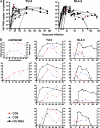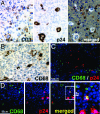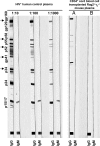Disseminated and sustained HIV infection in CD34+ cord blood cell-transplanted Rag2-/-gamma c-/- mice
- PMID: 17038503
- PMCID: PMC1635108
- DOI: 10.1073/pnas.0604493103
Disseminated and sustained HIV infection in CD34+ cord blood cell-transplanted Rag2-/-gamma c-/- mice
Abstract
Because of species selectivity, HIV research is largely restricted to in vitro or clinical studies, both limited in their ability to rapidly assess new strategies to fight the virus. To prospectively study some aspects of HIV in vivo, immunodeficient mice, transplanted with either human peripheral blood leukocytes or human fetal tissues, have been developed. Although these are susceptible to HIV infection, xenoreactivity, and short infection spans, resource and ethical constraints, as well as biased HIV coreceptor tropic strain infection, pose substantial problems in their use. Rag2(-/-)gamma(c)(-/-) mice, transplanted as newborns with human CD34(+) cells, were recently shown to develop human B, T, and dendritic cells, constituting lymphoid organs in situ. Here we tested these mice as a model system for HIV-1 infection. HIV RNA levels peaked to up to 2 x 10(6) copies per milliliter of plasma early after infection, and viremia was observed for up to 190 days, the longest time followed. A marked relative CD4(+) T cell depletion in peripheral blood occurred in CXCR4-tropic strain-infected mice, whereas this was less pronounced in CCR5-tropic strain-infected animals. Thymus infection was almost exclusively observed in CXCR4-tropic strain-infected mice, whereas spleen and lymph node HIV infection occurred irrespective of coreceptor selectivity, consistent with respective coreceptor expression on human CD4(+) T cells. Thus, this straightforward to generate and cost-effective in vivo model closely resembles HIV infection in man and therefore should be valuable to study virus-induced pathology and to rapidly evaluate new approaches aiming to prevent or treat HIV infection.
Conflict of interest statement
The authors declare no conflict of interest.
Figures





References
Publication types
MeSH terms
Substances
LinkOut - more resources
Full Text Sources
Other Literature Sources
Medical
Research Materials

